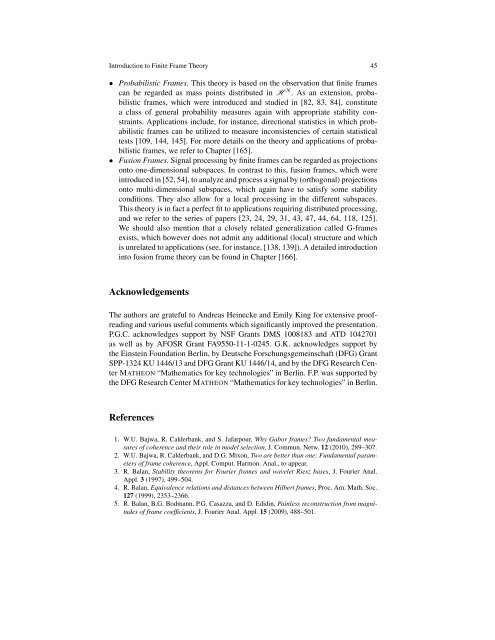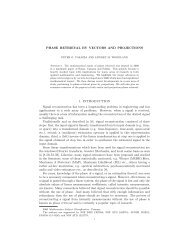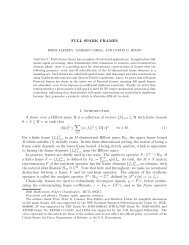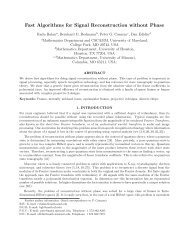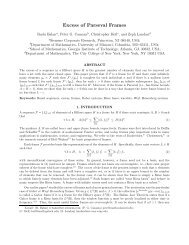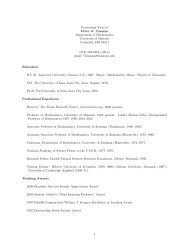Introduction to Finite Frame Theory - Frame Research Center
Introduction to Finite Frame Theory - Frame Research Center
Introduction to Finite Frame Theory - Frame Research Center
You also want an ePaper? Increase the reach of your titles
YUMPU automatically turns print PDFs into web optimized ePapers that Google loves.
<strong>Introduction</strong> <strong>to</strong> <strong>Finite</strong> <strong>Frame</strong> <strong>Theory</strong> 45<br />
• Probabilistic <strong>Frame</strong>s. This theory is based on the observation that finite frames<br />
can be regarded as mass points distributed in H N . As an extension, probabilistic<br />
frames, which were introduced and studied in [82, 83, 84], constitute<br />
a class of general probability measures again with appropriate stability constraints.<br />
Applications include, for instance, directional statistics in which probabilistic<br />
frames can be utilized <strong>to</strong> measure inconsistencies of certain statistical<br />
tests [109, 144, 145]. For more details on the theory and applications of probabilistic<br />
frames, we refer <strong>to</strong> Chapter [165].<br />
• Fusion <strong>Frame</strong>s. Signal processing by finite frames can be regarded as projections<br />
on<strong>to</strong> one-dimensional subspaces. In contrast <strong>to</strong> this, fusion frames, which were<br />
introduced in [52, 54], <strong>to</strong> analyze and process a signal by (orthogonal) projections<br />
on<strong>to</strong> multi-dimensional subspaces, which again have <strong>to</strong> satisfy some stability<br />
conditions. They also allow for a local processing in the different subspaces.<br />
This theory is in fact a perfect fit <strong>to</strong> applications requiring distributed processing,<br />
and we refer <strong>to</strong> the series of papers [23, 24, 29, 31, 43, 47, 44, 64, 118, 125].<br />
We should also mention that a closely related generalization called G-frames<br />
exists, which however does not admit any additional (local) structure and which<br />
is unrelated <strong>to</strong> applications (see, for instance, [138, 139]). A detailed introduction<br />
in<strong>to</strong> fusion frame theory can be found in Chapter [166].<br />
Acknowledgements<br />
The authors are grateful <strong>to</strong> Andreas Heinecke and Emily King for extensive proofreading<br />
and various useful comments which significantly improved the presentation.<br />
P.G.C. acknowledges support by NSF Grants DMS 1008183 and ATD 1042701<br />
as well as by AFOSR Grant FA9550-11-1-0245. G.K. acknowledges support by<br />
the Einstein Foundation Berlin, by Deutsche Forschungsgemeinschaft (DFG) Grant<br />
SPP-1324 KU 1446/13 and DFG Grant KU 1446/14, and by the DFG <strong>Research</strong> <strong>Center</strong><br />
MATHEON “Mathematics for key technologies” in Berlin. F.P. was supported by<br />
the DFG <strong>Research</strong> <strong>Center</strong> MATHEON “Mathematics for key technologies” in Berlin.<br />
References<br />
1. W.U. Bajwa, R. Calderbank, and S. Jafarpour, Why Gabor frames? Two fundamental measures<br />
of coherence and their role in model selection, J. Commun. Netw. 12 (2010), 289–307.<br />
2. W.U. Bajwa, R. Calderbank, and D.G. Mixon, Two are better than one: Fundamental parameters<br />
of frame coherence, Appl. Comput. Harmon. Anal., <strong>to</strong> appear.<br />
3. R. Balan, Stability theorems for Fourier frames and wavelet Riesz bases, J. Fourier Anal.<br />
Appl. 3 (1997), 499–504.<br />
4. R. Balan, Equivalence relations and distances between Hilbert frames, Proc. Am. Math. Soc.<br />
127 (1999), 2353–2366.<br />
5. R. Balan, B.G. Bodmann, P.G. Casazza, and D. Edidin, Painless reconstruction from magnitudes<br />
of frame coefficients, J. Fourier Anal. Appl. 15 (2009), 488–501.


